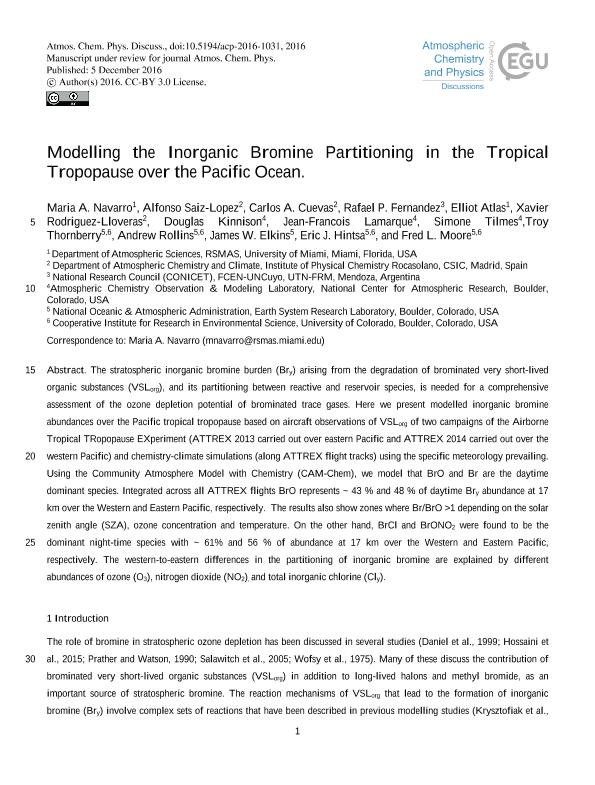Mostrar el registro sencillo del ítem
dc.contributor.author
Navarro, María A.
dc.contributor.author
Saiz-lopez, Alfonso

dc.contributor.author
Cuevas, Carlos Alberto

dc.contributor.author
Fernandez, Rafael Pedro

dc.contributor.author
Atlas, Elliot
dc.contributor.author
Rodriguez Lloeveras, Xavier
dc.contributor.author
Kinnison, Douglas E.

dc.contributor.author
Lamarque, Jean Francois
dc.contributor.author
Tilmes, Simone

dc.contributor.author
Thornberry, Troy
dc.contributor.author
Rollins, Andrew
dc.contributor.author
Elkins, James W.
dc.contributor.author
Hintsa, Eric J.
dc.contributor.author
Moore, Fred L.
dc.date.available
2020-03-25T15:05:02Z
dc.date.issued
2017-08
dc.identifier.citation
Navarro, María A.; Saiz-lopez, Alfonso; Cuevas, Carlos Alberto; Fernandez, Rafael Pedro; Atlas, Elliot; et al.; Modelling the Inorganic Bromine Partitioning in the Tropical Tropopause over the Pacific Ocean; Copernicus Publications; Atmospheric Chemistry and Physics; 17; 8-2017; 9917-9930
dc.identifier.issn
1680-7316
dc.identifier.uri
http://hdl.handle.net/11336/100680
dc.description.abstract
The stratospheric inorganic bromine burden (Bry) arising from the degradation of brominated very short-lived organic substances (VSL org ), and its partitioning between reactive and reservoir species, is needed for a comprehensive assessment of the ozone depletion potential of brominated trace gases. Here we present modelled inorganic bromine abundances over the Pacific tropical tropopause based on aircraft observations of VSL org of two campaigns of the Airborne Tropical TRopopause EXperiment (ATTREX 2013 carried out over eastern Pacific and ATTREX 2014 carried out over the western Pacific) and chemistry-climate simulations (along ATTREX flight tracks) using the specific meteorology prevailing. Using the Community Atmosphere Model with Chemistry (CAM-Chem), we model that BrO and Br are the daytime dominant species. Integrated across all ATTREX flights BrO represents ~ 43 % and 48 % of daytime Bry abundance at 17 km over the Western and Eastern Pacific, respectively. The results also show zones where Br/BrO >1 depending on the solar zenith angle (SZA), ozone concentration and temperature. On the other hand, BrCl and BrONO 2 were found to be the dominant night-time species with ~ 61% and 56 % of abundance at 17 km over the Western and Eastern Pacific, respectively. The western-to-eastern differences in the partitioning of inorganic bromine are explained by different abundances of ozone (O3), nitrogen dioxide (NO2) , and total inorganic chlorine (Cly).
dc.format
application/pdf
dc.language.iso
eng
dc.publisher
Copernicus Publications

dc.rights
info:eu-repo/semantics/openAccess
dc.rights.uri
https://creativecommons.org/licenses/by/2.5/ar/
dc.subject
TROPICAL WESTERN PACIFIC
dc.subject
INORGANIC BROMINE
dc.subject
VSL BROMINE
dc.subject
ATTREX
dc.subject.classification
Meteorología y Ciencias Atmosféricas

dc.subject.classification
Ciencias de la Tierra y relacionadas con el Medio Ambiente

dc.subject.classification
CIENCIAS NATURALES Y EXACTAS

dc.title
Modelling the Inorganic Bromine Partitioning in the Tropical Tropopause over the Pacific Ocean
dc.type
info:eu-repo/semantics/article
dc.type
info:ar-repo/semantics/artículo
dc.type
info:eu-repo/semantics/publishedVersion
dc.date.updated
2020-03-18T20:40:11Z
dc.identifier.eissn
1680-7324
dc.journal.volume
17
dc.journal.pagination
9917-9930
dc.journal.pais
Alemania

dc.journal.ciudad
Gottingen
dc.description.fil
Fil: Navarro, María A.. University of Miami; Estados Unidos
dc.description.fil
Fil: Saiz-lopez, Alfonso. Consejo Superior de Investigaciones Científicas. Instituto de Química Física; España
dc.description.fil
Fil: Cuevas, Carlos Alberto. Consejo Superior de Investigaciones Científicas. Instituto de Química Física; España
dc.description.fil
Fil: Fernandez, Rafael Pedro. Consejo Nacional de Investigaciones Científicas y Técnicas. Centro Científico Tecnológico Conicet - Mendoza; Argentina. Universidad Nacional de Cuyo. Facultad de Ciencias Exactas y Naturales; Argentina. Universidad Tecnologica Nacional. Facultad Regional Mendoza. Secretaría de Ciencia, Tecnología y Postgrado; Argentina
dc.description.fil
Fil: Atlas, Elliot. University of Miami; Estados Unidos
dc.description.fil
Fil: Rodriguez Lloeveras, Xavier. Consejo Superior de Investigaciones Científicas. Instituto de Química Física; España
dc.description.fil
Fil: Kinnison, Douglas E.. National Center For Atmospheric Research. Amospheric Chemistry División; Estados Unidos
dc.description.fil
Fil: Lamarque, Jean Francois. National Center For Atmospheric Research. Amospheric Chemistry División; Estados Unidos
dc.description.fil
Fil: Tilmes, Simone. National Center For Atmospheric Research. Amospheric Chemistry División; Estados Unidos
dc.description.fil
Fil: Thornberry, Troy. State University of Colorado at Boulder; Estados Unidos. Earth System Research Laboratory; Estados Unidos
dc.description.fil
Fil: Rollins, Andrew. State University of Colorado at Boulder; Estados Unidos. Earth System Research Laboratory; Estados Unidos
dc.description.fil
Fil: Elkins, James W.. Earth System Research Laboratory; Estados Unidos
dc.description.fil
Fil: Hintsa, Eric J.. State University of Colorado at Boulder; Estados Unidos. Earth System Research Laboratory; Estados Unidos
dc.description.fil
Fil: Moore, Fred L.. State University of Colorado at Boulder; Estados Unidos. Earth System Research Laboratory; Estados Unidos
dc.journal.title
Atmospheric Chemistry and Physics

dc.relation.alternativeid
info:eu-repo/semantics/altIdentifier/doi/http://dx.doi.org/10.5194/acp-2016-1031
dc.relation.alternativeid
info:eu-repo/semantics/altIdentifier/url/https://www.atmos-chem-phys.net/17/9917/2017/
Archivos asociados
